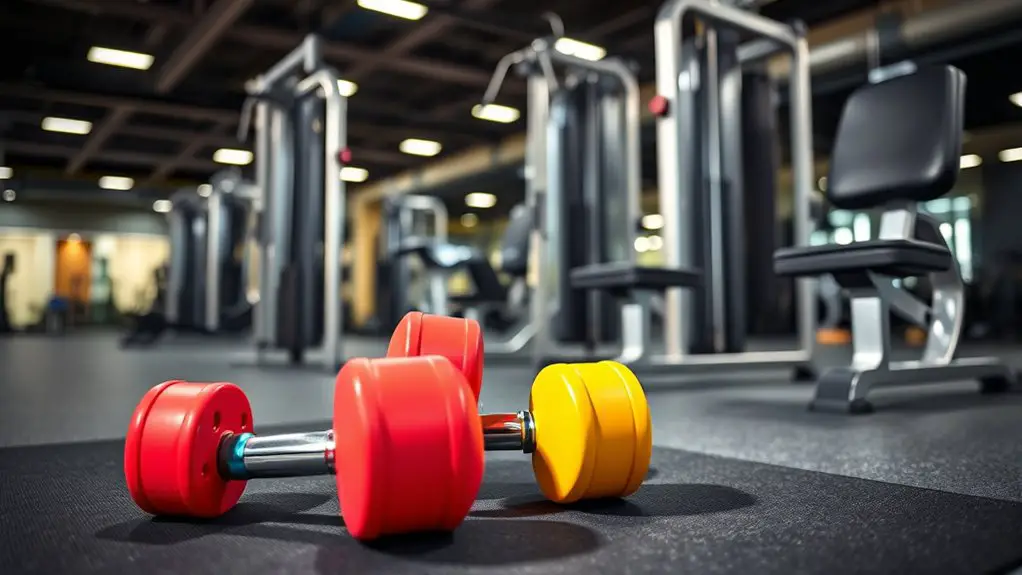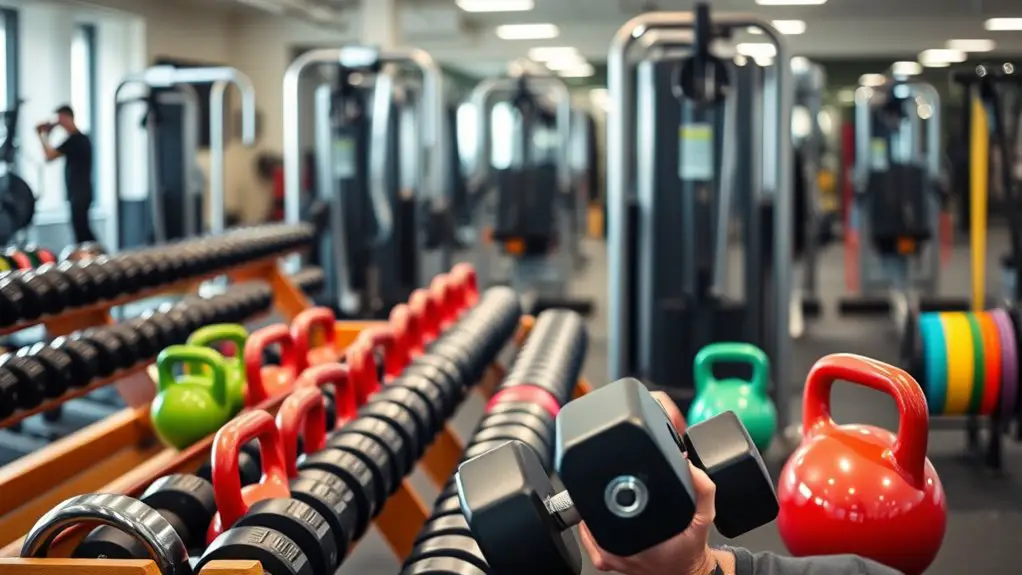A Beginner’s Guide to Free Weights vs. Machines

When starting your fitness journey, both free weights and machines have their benefits. Free weights, like dumbbells and barbells, engage multiple muscle groups and improve functional strength, while machines offer stability and guided movements, making them ideal for beginners. To maximize your workouts, consider incorporating both methods. As you explore your fitness options, you’ll uncover even more tips and strategies to help you achieve your goals effectively.
Understanding Free Weights

When you think about free weights, you might picture dumbbells and barbells that allow for a more versatile workout. Understanding free weight fundamentals is essential for guaranteeing safety as you begin your fitness journey. Unlike machines, free weights require you to engage stabilizing muscles, which can enhance your overall strength.
When considering equipment selection, start with lighter weights to master proper form before progressing. This helps prevent injuries and builds a strong foundation. Always prioritize safety; use a spotter when necessary and guarantee your workout area is clear of obstacles.
It’s also a good idea to familiarize yourself with various exercises targeting different muscle groups. This knowledge not only maximizes your workout but also keeps your routine diverse and interesting. By grasping these basics, you can confidently embrace free weights as a valuable addition to your fitness regimen.
Benefits of Free Weights
When you choose free weights, you’re not just lifting; you’re engaging more muscles and building greater functional strength. This approach also improves your flexibility and coordination, making everyday movements easier. Let’s explore how these benefits can enhance your overall fitness journey.
Improved Muscle Engagement
While machines can provide a structured approach to strength training, free weights often lead to improved muscle engagement. When you use free weights, your body activates more muscles, enhancing muscle activation across various movement patterns. This means you’re not just working the target muscles; you’re also engaging stabilizing muscles, which can help improve your overall strength and coordination.
Greater Functional Strength
Building greater functional strength is one of the standout benefits of using free weights in your training routine. When you lift free weights, you’re not just building muscle; you’re enhancing your functional capacity for daily activities. This type of strength training mimics real-life movements, helping you perform everyday tasks with ease and reducing injury risk.
| Free Weights | Machines |
|---|---|
| Engage multiple muscles | Target specific muscles |
| Improve stability | Limited range of motion |
| Enhance coordination | Focus on isolation |
Enhanced Flexibility and Coordination
Using free weights not only strengthens your muscles but also enhances your flexibility and coordination. When you lift free weights, you’re engaging your entire body, which improves your balance training. This means you’ll develop better stability during daily activities, reducing your risk of injury. Additionally, working with free weights fosters body awareness, as you learn to control your movements and understand how your body responds to different exercises. By focusing on proper form, you’ll build a strong foundation that translates to better performance in both workouts and everyday tasks. Remember, starting with lighter weights can help you prioritize safety while you master your technique. Embrace free weights to enjoy a well-rounded approach to fitness that promotes flexibility and coordination.
Common Free Weight Exercises
Free weights offer a versatile way to enhance your strength training routine, with a variety of exercises that target multiple muscle groups. To build a solid foundation, try barbell squats and goblet squats for your legs. For upper body strength, incorporate the dumbbell bench press, overhead press, and bicep curls. Don’t forget about tricep extensions and bent-over rows to guarantee balanced training.
Kettlebell swings are fantastic for developing explosive power and endurance, while deadlift variations can strengthen your back and legs effectively. You can also include various lunges variations to work on stability and coordination.
Always remember to maintain proper form and start with lighter weights to minimize injury risk. As you gain confidence and strength, gradually increase the weight. This approach will help you enjoy the benefits of free weights safely.
Exploring Weight Machines

While many people gravitate towards free weights for their versatility, exploring weight machines can also be a valuable addition to your strength training routine. Weight machines come in various types, such as selectorized, cable, and plate-loaded, each designed to target specific muscle groups safely. These machines often include safety features like guided movement paths and adjustable weights, allowing you to focus on form without the risk of dropping heavy weights.
One of the key machine benefits is the support they offer, especially for beginners. They help stabilize your body, minimizing the chance of injury while you build strength. Additionally, many machines have clear instructions, making it easier to learn proper techniques. By incorporating weight machines into your workouts, you can diversify your training and enhance your overall fitness, all while ensuring a safer exercise environment.
Advantages of Weight Machines
When you use weight machines, you get an added layer of safety and stability, making your workouts feel more secure. These machines are designed to isolate specific muscles, helping you focus on targeted areas without the risk of injury. If you’re looking for a controlled environment to enhance your strength training, weight machines might be the right choice for you.
Safety and Stability
Using weight machines can greatly enhance safety and stability during workouts, especially for beginners or those recovering from injuries. Unlike free weights, machines provide built-in equipment stability, helping you maintain proper form and reducing the risk of injury. This is particularly beneficial if you’re unsure about spotting techniques, as machines often guide your movements along a fixed path, minimizing the chances of accidents. You won’t have to worry about balancing weights or having a spotter, allowing you to focus on your workout. Additionally, many machines come with adjustable settings, ensuring they fit your body size and strength level. Overall, using weight machines is a smart choice for a safer and more controlled exercise experience.
Targeted Muscle Isolation
One of the key advantages of weight machines is their ability to isolate specific muscle groups effectively. This makes them perfect for targeted exercises, allowing you to focus on particular areas without worrying about balance or technique as much. Machines often have guided movements, which can help guarantee you’re using proper form, reducing the risk of injury.
| Muscle Group | Targeted Exercise |
|---|---|
| Chest | Chest Press |
| Legs | Leg Press |
| Back | Lat Pulldown |
Popular Weight Machine Exercises

Several popular weight machine exercises can help you target specific muscle groups effectively. For instance, the leg press machine is great for your quadriceps and hamstrings. To perform this exercise safely, adjust the seat to make certain your knees align with your toes. Another effective option is the chest press, which works on your pectoral muscles. Make sure to choose an appropriate weight that allows you to complete your exercise sequences with good form.
You can also try the lat pulldown machine, focusing on your back muscles. Remember to control the movement and avoid jerking the machine. Finally, the seated row machine targets your upper back and biceps; keep your back straight to minimize injury risk. By exploring these machine variations, you can create a balanced workout routine that emphasizes safety and efficiency. Always listen to your body and adjust your routine as needed.
Safety Considerations
When it comes to weight training, prioritizing safety can make all the difference in your progress and overall well-being. To guarantee a safe workout, focus on proper form and gradually progress in intensity. Always assess your fitness level and know your personal limits.
Maintaining a safe workout environment is essential; keep the area tidy and confirm your equipment is well-maintained. If you’re using free weights, use spotting techniques to prevent accidents.
Here’s a quick reference table to guide your safety measures:
| Safety Aspect | Key Tips |
|---|---|
| Proper Form | Focus on technique first |
| Injury Prevention | Warm up and cool down |
| Equipment Maintenance | Regularly check for damage |
| Spotting Techniques | Use a partner for heavy lifts |
Choosing the Right Option for Your Goals
How do you determine whether free weights or machines are better suited for your fitness goals? Start by considering your goal setting. If you aim to build overall strength and improve stability, free weights might be your best bet. They engage multiple muscle groups and require balance, which can enhance functional strength. However, if you’re new to working out or recovering from an injury, machines can offer a safer option. They provide guided movements and help you target specific muscles, reducing the risk of injury.
Next, think about your workout preferences. If you enjoy a variety of exercises and the flexibility to change your routine, free weights could keep things exciting. On the other hand, if you prefer a structured environment with less intimidation, machines might suit you better. Ultimately, choose the option that aligns with your goals and comfort level to guarantee a safe and enjoyable fitness journey.
Combining Free Weights and Machines
Combining free weights and machines can really enhance your workouts. It lets you tailor your routine to meet specific goals while balancing strength and technique. By using both methods, you can maximize your gains and improve overall performance.
Benefits of Combining Methods
While many fitness enthusiasts have their preferences, blending free weights and machines can enhance your workout experience considerably. This hybrid training approach offers you the best of both worlds, allowing for improved strength gains and stability. By combining methods, you can target different muscle groups effectively while reducing the risk of injury. Machines provide support and control, making them great for beginners, while free weights promote functional strength and balance. Plus, incorporating both methods adds workout variety, keeping your routine fresh and engaging. You’ll not only enjoy a more thorough workout but also see better overall results. So, consider mixing free weights and machines to create a balanced, safe, and effective training regimen.
Tailoring Workouts to Goals
To achieve your fitness goals, it’s essential to tailor your workouts by incorporating both free weights and machines. This combination allows you to create goal specific workouts that enhance your strength and stability while minimizing injury risks. Free weights improve your core stability and functional strength, while machines offer guided movements that can help you focus on specific muscle groups safely.
Personalized training is key, so consider your objectives—whether it’s building muscle, losing weight, or enhancing endurance. You might start with machines to perfect your form and then shift to free weights for a more dynamic challenge. By blending both methods, you can enjoy a balanced workout routine that supports your individual fitness journey effectively and safely.
Balancing Strength and Technique
Finding the right balance between strength and technique can greatly enhance your workouts. Combining free weights and machines allows you to achieve both strength progression and technique mastery. Here are some tips to help you find that balance:
- Start with machines: They provide stability and help you focus on form.
- Incorporate free weights: Once you’ve mastered the basics, they’ll challenge your balance and engage more muscles.
- Use lighter weights: Prioritize form over heavy lifting to reduce injury risk.
- Mix your routine: Alternate between machines and free weights to keep workouts fresh and balanced.
Tips for Beginners
Starting a fitness journey can feel overwhelming, but it doesn’t have to be. To stay safe and effective, focus on learning proper form before increasing weights or resistance. This helps prevent injuries and guarantees you’re targeting the right muscles. If you’re unsure about your technique, don’t hesitate to ask a trainer for guidance or watch instructional videos.
When it comes to workout progression, start with lighter weights or machines that allow you to master the basics. Gradually increase the intensity as you gain confidence and strength. Remember, it’s perfectly okay to take your time—everyone progresses at their own pace. Additionally, consider familiarization with gym layout to make your first experiences more comfortable.
Finally, always listen to your body. If something doesn’t feel right, stop and reassess. Consistency is key, so stay committed and enjoy the journey. You’re building a foundation for lifelong fitness, and that’s something to celebrate!
Frequently Asked Questions
Can I Build Muscle Solely Using Machines?
Yes, you can build muscle solely using machines. They offer several benefits, like stability and safety, making them great for beginners or those concerned about injury. Machines target specific muscle groups effectively, promoting muscle growth while reducing the risk of improper form. However, incorporating a variety of equipment can enhance your progress. If you’re focused on safety and want to maximize your results, machines can definitely be a valuable part of your routine.
Are Free Weights Safer Than Machines for Beginners?
Studies show that beginners using machines experience a 50% lower injury risk compared to those using free weights. However, this doesn’t mean free weights are inherently unsafe. With proper form and guidance, you can effectively minimize injury risks while using them. Machines often provide more stability, which can help you focus on mastering your technique. Ultimately, it’s essential to prioritize safety and find what works best for your fitness journey.
What’s the Cost Difference Between Free Weights and Machines?
When you look at the cost comparison between free weights and machines, you’ll find that free weights usually require a lower initial equipment investment. Dumbbells and kettlebells can be quite affordable, while machines often come with a higher price tag due to their complexity. However, don’t forget that investing in quality equipment, regardless of the type, can enhance your safety and workout experience, so choose what fits your budget and fitness goals best.
How Do I Clean and Maintain My Free Weights?
A clean weight is a happy weight, and maintaining yours is essential. To keep your free weights in top shape, use basic cleaning techniques like wiping them down with a damp cloth after each use. Store them securely to prevent damage and accidents—consider a dedicated rack. Regularly inspect for rust or wear, and address any issues promptly. Safety’s key, so always prioritize a tidy, well-organized workout space for your peace of mind!
Should I Use Both Free Weights and Machines in My Routine?
You should definitely consider using both free weights and machines in your strength training routine. Combining them can enhance your workout variety, targeting different muscle groups effectively. Machines offer stability and can help prevent injuries, especially when you’re starting out or trying new exercises. Free weights, on the other hand, promote balance and engage stabilizing muscles. By integrating both, you’ll create a safer and more well-rounded strength training program that keeps you motivated and progressing.





